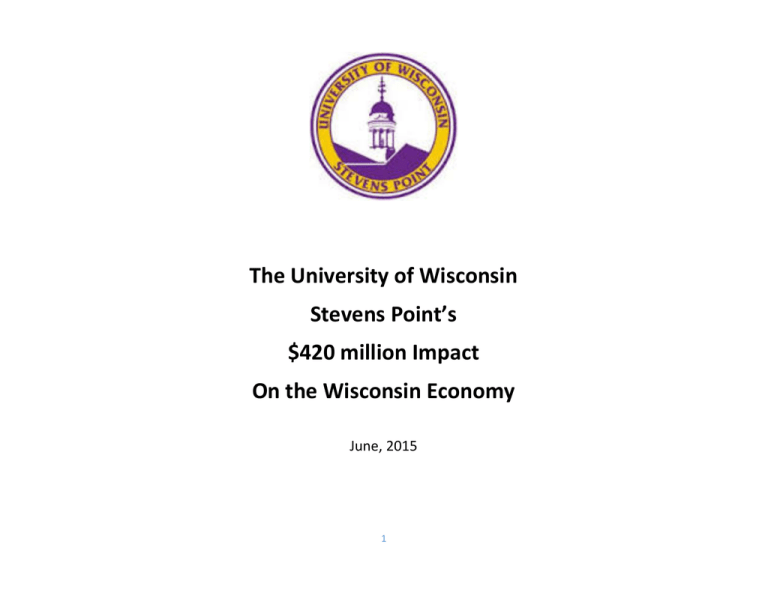The University of Wisconsin Stevens Point’s $420 million Impact
advertisement

The University of Wisconsin Stevens Point’s $420 million Impact On the Wisconsin Economy June, 2015 1 Acknowledgements NorthStar Consulting would like to thank the University of Wisconsin-Stevens Point for their assistance in updating the 2011 comprehensive economic impact study. The support and assistance we received from the university personnel was greatly appreciated. We thank Chancellor Bernie L. Patterson, as well as Vice Chancellor for Business Affairs, Greg Diemer, Controller Bo (Daryl) DeDeker and Budget Director, Erin Hintz who presented the necessary information to complete the economic analysis. Special thanks to Dr. Russ Kashian, Director of UW-Whitewater’s Fiscal and Economic Research Center, for his quality work and project advice. Dr. Bruce Siebold (715) 577-5177 2 Table of Contents Executive Summary .......................................................................................................................................................................................................... 4 Splash Page ....................................................................................................................................................................................................................... 5 Purpose and Scope ........................................................................................................................................................................................................... 6 Economic Impact of UW-Stevens Point ............................................................................................................................................................................ 7 Direct Economic Impact of UW-Stevens Point ................................................................................................................................................................. 9 Impact of UW-Stevens Point on Wisconsin Jobs .............................................................................................................................................................. 10 UW-Stevens Point Tax Revenue Impact ........................................................................................................................................................................... 11 Return on Public Investment ............................................................................................................................................................................................ 12 Methodology .................................................................................................................................................................................................................... 13 3 Executive Summary UW-Stevens Point (UWSP) contributes over $420 million per year to the Wisconsin economy, while supporting 4,934 Wisconsin jobs and generating $21.2 million in state tax revenue. The University of Wisconsin-Stevens Point is one of eleven comprehensive universities in the UW System. The economic impact of UWSP comes from spending in the Wisconsin economy. The sources of related spending include operations, faculty and staff, students, and visitors. The total economic impact comes from two sources: the direct spending of faculty and staff, students, visitors and University operations, and indirect and induced spending, which results from direct spending cycling through the regional and state economy. The spending from businesses that benefit from the direct spending of faculty and staff, students, visitors, and UWSP operations creates additional indirect or induced economic activity that results in jobs and taxes generated within the state. 4 THE ECONOMIC IMPACT OF THE UNIVERSITY OF WISCONSIN-STEVENS POINT Annual Impact on the Wisconsin Economy: • $420.2 million in total impact on the Wisconsin economy • 4,934 Wisconsin jobs created and supported • $21.2 million in state and local tax revenue generated 5 Purpose and Scope The purpose of this study is to measure the economic impact that the University of Wisconsin-Stevens Point has on the state economy. The university’s economic impact comes from spending in operations on the campus, spending of faculty, staff, students and visitors. The spending from these sources, in turn, creates jobs and generates tax revenue. The study updates an economic impact study done for UW-Stevens Point in 2011. The basic methodology used in this study is consistent with that used in the prior study. 6 Economic Impact of UWStevens Point The economic impact of UW-Stevens Point comes from spending in the Wisconsin economy. The sources of related spending include operations, faculty and staff, students, and visitors. The total economic impact comes from two sources: 1. The direct spending of faculty and staff, students, visitors and university operations. Direct spending supports local and state businesses and those businesses in turn employ workers and spend money in the state economy. 2. Indirect or induced spending results from direct spending cycling through the regional and state economy. The spending from businesses that benefit from the direct spending of faculty and staff, students, visitors, and university operations creates additional indirect or induced economic activity that results in jobs and taxes generated within the state. Direct spending of nearly $269.5 million feeds the economic engine that in turn generates over $150.5 million in additional economic activity. Direct spending of $269.5 million feeds the economic engine that in turn generates more than $150.5 million in indirect and induced spending. Overall, the sum of this economic activity is over $420 million. 7 The $420 million of economic impact comes from a variety of sources: Figure 1. UW-Stevens Point Economic Impact to the State of Wisconsin Contributor Contribution Employees $144.0 Students $115.5 Institution $90.5 Visitors $70.0 Total $420.0 % Share 34.2% 27.5% 21.5% 16.8% 100% Figure 2. Sources of UW-Stevens Point Economic Impact to the State of Wisconsin Sources of UW-Stevens Point's Economic Impact to the State of Wisconsin 28% 17% Visitors Employees Institution 21% 8 34% Students Direct Economic Impact of UW-Stevens Point Figure 4. UW-Stevens Point Direct Spending by Category UW-Stevens Point Beneficiary by Category UW-Stevens Point related direct spending in the state economy amounts to more than $269.5 million per year. The primary contributors of that spending are students, employees, visitors, and UW-Stevens Point’s non-payroll spending for operations of the university. 2% 6% 0% This spending contributes more than $26.5 million to local government revenue and more than $6.7 million to not-for profits or charities. Private Business Households Not-for-profits The primary beneficiary of UW-Stevens Point’s economic impact is private business which results in $385.6 million in economic spending. 92% Figure 3. UW-Stevens Point Economic Impact Beneficiary Categories Contributor Recipient Private Business Local Government Not-for-profits Households TOTAL Spending $385.6 million $26.5 million $6.7 million $1.2 million $420 million 9 Local Government Impact of UW-Stevens Point on Wisconsin Jobs Spending related to UW-Stevens Point has a significant impact on Wisconsin jobs. Jobs attributable to UWStevens Point occur in five ways: • • • • • Faculty and staff are directly hired by the university to teach, conduct research, do public service, and perform a variety of administrative functions Operational spending creates jobs in regional and state businesses Employee spending creates jobs in the region and state Student spending creates jobs in the region and state Visitor spending creates jobs in the hospitality and related industries UW-Stevens Point’s tax impact results from the overall economic activity of the university. UW-Stevens Point faculty and staff pay state income taxes on their university and other income. They pay sales taxes on many types of expenditures. Faculty and staff spending and the spending of the university on operations generate jobs. Those jobs in turn generate income taxes, sales taxes and property tax payments. The spending of students and visitors generates sales taxes. That spending, in turn, creates jobs, and spending from those jobs generates sales and income taxes. Overall, UW-Stevens Point economic activity generates more than $21.2 million in state and local tax revenue. Figure 5. UW-Stevens Point Impact on Jobs (Full-Time Equivalent) Job Generator Employees directly employed by the UWSP Employee spending Student spending Operational spending Visitor spending Total Job Impact 10 Jobs 1458 1189 956 747 584 4934 UW-Stevens Point Tax Revenue Impact The economic activity generated by UW-Stevens Point results in state and local tax revenue. The tax revenue comes from state income tax payments, sales tax payments and payments for local property taxes. The sources of that tax revenue are shown in Figure 6 and 7. Figure 7. Sources of Tax Revenue Generated by UW-Stevens Point 17% 21% Operational expenditures Employee spending & income tax payments 28% 34% Student spending Visitor spending Figure 6. UW-Stevens Point State and Local Tax Revenue Impact Tax Revenue Source Employee spending & state income tax payments Student spending Operational expenditures Visitor spending Total Tax Revenue Tax Revenue $7.25 million $5.83 million $4.55 million $3.56 million $21.2 million 11 Return on Public Investment For every $1.00 of state tax investment in the university, there is $11.00 in economic activity in the State of Wisconsin. The University of Wisconsin-Stevens Point is a wellrespected public university. The university is based upon public investment in higher education that goes back to the founding of the State of Wisconsin in 1848. For over 120 years, the citizens of the State of Wisconsin have supported the teaching, research and public service missions of UW-Stevens Point. Without the annual public investment by the State of Wisconsin, UW-Stevens Point could not generate the total economic impact reported in this study. As economic conditions have changed, the university has drawn resources from other sources to complement state investment. The state’s contribution to the university’s budget in 2014-15 in state tax dollars was $38.3 million. The total economic impact of UW-Stevens Point in 2014-15 was $420 million. For every $1.00 of state tax investment in the university, there is $11.00 in economic activity in the State of Wisconsin. 12 Methodology for example). As a result, the subsequent spending cycles decrease in impact. In order to identify and estimate the total economic contribution that any organization or activity makes to the state or regional economy, it is necessary to look beyond the direct expenditures made by the organization itself. There is a “ripple effect” of the expenditures made for goods and services related to the activity. Wages paid to workers are spent on housing, food, clothing, entertainment, etc. By the same token, business revenues generated from supplying foods and services to UW-Stevens Point are paid out in wages, and costs of additional goods and services, costs of living, etc. This multiplier effect is accounted for both in terms of indirect effects of the direct spending, as well as induced effects (essentially, the further effects of the indirect effects) to calculate total economic impact. Tax withholding estimates and other leakages were subtracted from gross payroll figures to determine payroll expenditures that benefit the regional economy. Economic multiplier models are the framework for analyzing economic impact. Derived mathematically, these models estimate the magnitude and distribution of economic impact and measure three types of effects: direct, indirect, and induced changes within the economy. Direct effects are determined by the amount of the initial spending. Indirect effects are determined by the amount of the direct effect spent within the study region on supplies, services, labor and taxes. Finally, the induced effect measures the money that is respent in the study area as a result of spending from the indirect effect. Each of these steps recognizes an important leakage from the economic study region spent on purchases outside of the defined area. The “multiplier effect” refers to the recurrent economic activity generated by an initial expenditure. For example, money spent directly on construction will cycle through the local economy again as wages to the tradesmen, purchases of construction materials such as lumber, tools and nails, gasoline for machinery and worker transportation. The initial wave of spending generates a second and third wave of spending as wages paid and profits made on the direct construction spending spins through the economy in several cycles. Thus, the original direct expenditure yields a greater economic impact than just the money initially spent. Some money “leaks out” of the regional economy at each level as some spending is done outside the region (some goods purchased may originate in another state, 13




